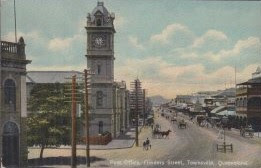Queensland 1860
Not yet completely worked up and put in Deep Blue
Into the Deep Blue
Is the way one collects ( and later sell) changing?
Is there a fundamental shift in our hobby?
For this blog post, I will rely on the measured opinions of Ron Leith of Vancouver, B.C.
He has a quite successful Auction House, with postal history as a specialty.
He submitted an opinion piece in the August 2023 Oregon Stamp Society "The Album Page" newsletter which was featured in the "President's Corner" section.
I contacted Ron and he graciously has allowed this blog post to include his comment. In addition, he sent me an email that elaborated on his comment. Thanks Ron!
Shall we see what he has to say?
Ron Leith Comment for the Oregon Stamp Society Newsletter
Click to enlarge script
"The stamp market is changing rapidly with the majority of
pre-2020 Public Auctions closing down as a result of escalating operating costs
and internet competition. It's the few remaining PUBLIC AUCTIONS
that are realizing record prices for rarities, however, they now have no time
or staff to sort general country collections. These are sold by the box,
usually with no catalog value, no total stamp count, and no lot scans.
Only dealers that attend the auction get the chance to inspect them. As
there is little competition from collectors for box lots at a live
auction, they typically sell for under 5% of the catalog value and often
under 1% of catalog. This partially explains the current glut of
country collections offered at incredibly low prices by dealers in both Europe
and North America"
Elaborative Comment via email
Queensland 1860-61
Noy yet completely worked up and put in Deep Blue
Ron Leith Comment for the Oregon Stamp Society Newsletter
Click to enlarge script
"Fortunately, there are many good internet auctions that
effectively handle collections. Of course, world class rarities should be
sent to a successful public auction, then it is recommended to carefully choose
an internet auction that knows how to get the most out of a country
collection. Internet auctioneers are also very busy and short
staffed, so there are "must-do" things to consider when selling
a stamp collection. It is essential that the collector identifies
the catalog number and price for all the $400+ catalog value no fault complete
sets and single stamps in the collection. Then a list for the total
number of stamps and a catalog value for the remaining collection is necessary.
By following this simple procedure, realizing 20%-40% for good sets &
singles is achievable with higher prices for choice items. Internet
estimated prices for remainder collections normally start at 10% of the catalog
value with potential sales in the15%-25% catalog range that is directly
proportional to the quality of lot scans. Thus, one can easily
realize double or more in sales revenue compared to sending the entire
collection to a Public Auction."
Elaborative Comment via email

Queensland 1861-62
Noy yet completely worked up and put in Deep Blue
"Internet auctions don't offer their services for free,
consequently, the more description input the collector makes, the lower the
auction fees. These fees can range from 15% of sales up to 50% depending
on how many man-hours it takes to prepare the collection. If one does not
want to describe their collection in detail, most internet auctions will also
buy collections outright. As a result of the modest internet sales prices
mentioned above, it is no surprise that the current fair market price offered
to collections is in the 10% of catalog range. Even bourse and store
dealer offers at 5% of catalog are now reasonable since they have to do the
description work and often have to carry inventory for years before selling the
stamps at 20%-30% of current catalog prices."
Further elaborative comment via email
Queensland 1863-65
Not yet completely worked up and put in Deep Blue
Out of the Blue
There is much to digest here for the WW classical era collector.
Some of the points he makes are:
( My own opinion/ take follows in parenthesis.)
1) Major Auction houses list primarily high value individual lots. The auction house costs are too high to do more.
(Generalized country collections - whether part of a WW collection or an individual country collection - even if very nice but not spectacular - is no longer much of an interest to major auctions, as that market goes to fairly expensive individual stamps or interesting postal history.)
2) There are too many large collections hitting the market - and little time to process them. Consequently, they are sold in large lots, mainly to dealers.
( There is a glut of country collections available to dealers, and the collector can expect a low CV offer, if any. Country collections are often sold as bulk lots, and can be had for not much ( good news if buying, bad news if selling)..
3) If one is internet savvy, one can list the the lots for resale, and one can make a decent return.
( If the individual collector does not make the time/effort to market on the internet, the collector will need to be satisfied with wholesale prices for one's collection. But a decent alternative is to have an internet dealer sell "On Consignment" for you, where he takes a % of the proceeds. )
Comments appreciated!



















.jpg)
.jpg)
.jpg)


.jpg)
.jpg)
.jpg)


.jpg)
.jpg)
.jpg)






.jpg)

